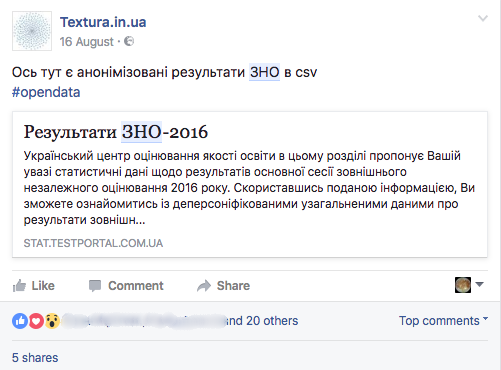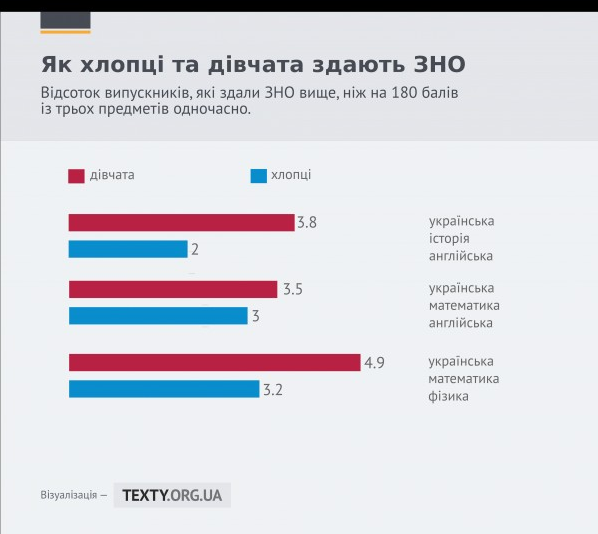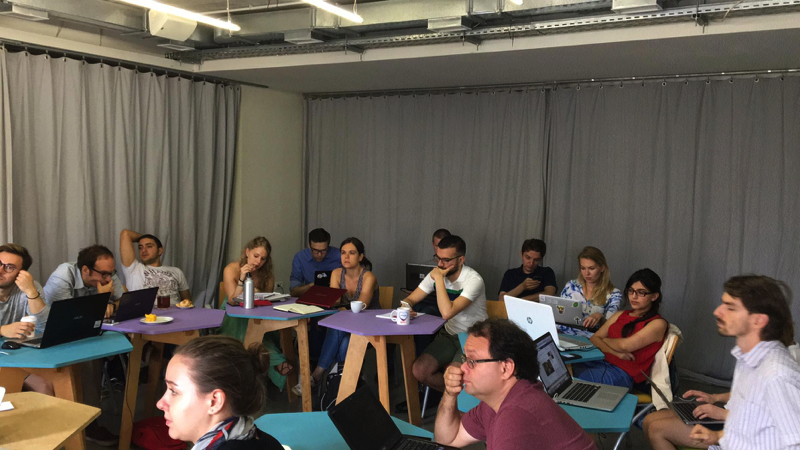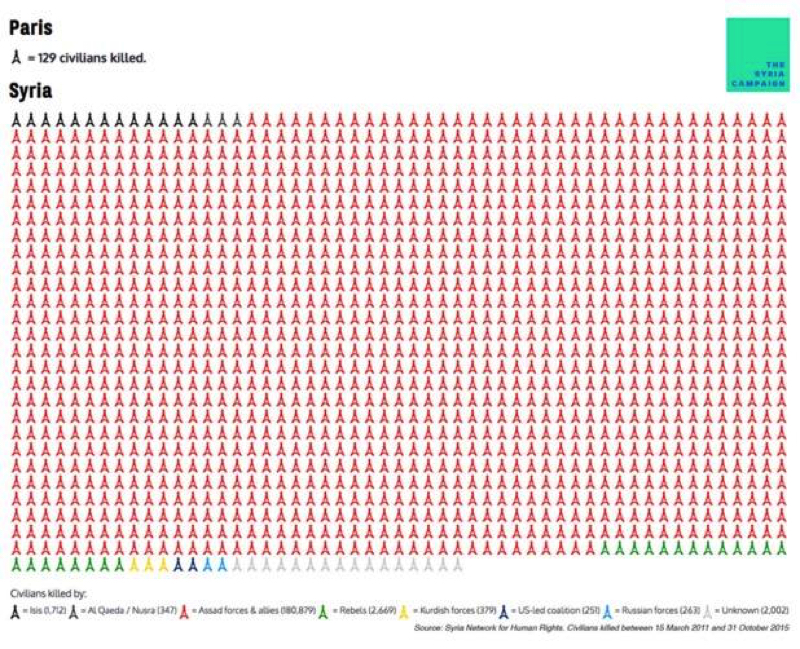De-anonymising Ukraine university entrance test results
Vadym Hudyma - May 26, 2017 in Data Blog
Authors: Vadym Hudyma, Pavlo Myronov. Part 1 of a series on Ukrainian student data.
Introduction
External Independent Evaluation Testing is a single exam is used nationwide to access all public universities.
As detailed in our previous article, the release of a poorly anonymised dataset by organisation in charge of the External Independent Evaluation Testing (EIT) resulted in serious risks to the privacy of Ukrainian students. One of those was the risk of unwanted mass disclosure of personal information, with the help of a single additional dataset. We detail below how we reached our results.
The EIT datasets contains the following dimensions:
- Unique identifier for every person
- Year of birth
- Sex
- Test scores of every subject taken by student (for those who get 95% and more of possible points – exact to decimals)
- Place, where test were taken
On the other hands, the dataset we used to de-anonymise the EIT results, was collected from the website vstup.info, and it gives us access to the following elements:
- family name and initials of the applicant (also referred below to as name)
- university where the applicant was accepted
- the combined EIT result scores per required subject, with a multiplier applied to each subject by the universities, depending on their priorities.
At first glance, as every university uses its own list of subject-specific multipliers to create the combined EIT results of applicants, it should be impossible to precisely know their EIT score, as well as find matches with exact scores in EIT data set.
The only problem with that reasoning is that the law requires all the multipliers to be published on the same website as a part of a corruption prevention mechanism. And this is good. But it also provides attackers with enough data to use it as a basis for calculation to find exact matches between datasets.
How we did it
Our calculations were based on an assumption that every EIT participant applied to universities of their local region. Of course, this assumption may not be true for every participant but it’s usually the case and also one of the easiest ways to decrease the complexity of the calculations.
For every Ukrainian region, we isolated in the EIT dataset a subset of local test-takers and calculated the EIT ratings they would have if they had applied for every speciality at local universities. Then we merged this dataset of “potential enrollees” with real enrollees’ dataset from website vstup.info, which contained real names of enrollees and their final rating (meaning multiplied by subject- and university specific multipliers) by the parameters of the university, speciality, and rating.
By joining these data sets for every region we gained the first set of pairs, where test-takers’ ids correspond with enrollees’ names (data set A1B1). In the resulting set, the quantity of EIT participants that correspond with only one name, i.e. those who can be unambiguously identified, is 20 637 (7.7% of all participants).
To expand the scope of our de-anonymization, we used the fact that most of the enrollees try to increase their chances of getting accepted by applying to several universities. We consequently tested all pairs from first merged dataset (A1B1) against the whole dataset of enrollees (B1), counting the number of matches by final rating for the every pair. Then we filtered the pairs that were matched by at least two unique values of EIT rating. If the same match occurs in two cases with different universities/speciality coefficients to form aggregate EIT rating, it’s much less likely that we got a “false positive”.
Therefore, we formed a data set where each EIT participant’s id corresponds with one or more names, and the number of unique EIT rating values is recorded for every correspondence (C1). In this case, the number EIT participant (unique identifier from A1) that correspond only one name with the number of unique aggregate ratings > 1, is 50 845 (18.97%).
We also noticed the possibility of false positive results, namely the situation where the same family name and initials from enrollees dataset (B1) corresponds with several ids from EIT participants dataset (A1). It doesn’t necessary mean we guessed test taker’s family name wrongly, especially in a case of rather common a family name. The more widespread name is, the more the probability that we have correctly identified several EIT participants with the same name. But still it leaves possibilty of some number of false positive results.
To separate the most reliable results from others, we identified correspondences with unique names and calculated the number of the records where unique id corresponds with a unique name.
Consequently, the results of our de-anonymization can be described by the following table.
| Assumptions | De-anonymized EIT participants with unique names | De-anonymized EIT participants (regardless of names uniqueness) |
| 1) Every enrollee applied to at least one university in his/her region. | 8 231 (3.07%) | 20 637 (7.7%) |
| 1) + Every enrollee applied to at least two specialities with different coefficients. | 31 418 (11.42%) | 50 845 (18.97%) |
In each row, false positive results can occur only if some of the enrollees broke basic assumption(s).
So far we speaking about unambiguous identification of test-takers. But even narrowing results to a small number of possible variants makes subsequent identification using any kind of background knowledge or other available data sets trivial. At the end, we were able to identify 10 and less possible name-variants for 43 825 EIT participants. Moreover, we established only 2 possible name-variants for 19 976 test-takers.
Our method provides assumed name(or names) for every EIT participant, who applied to university in the region where they had taken their tests, and applied to at least two specialities with different multipliers. Though not being 100% free from false positives, the results are precise enough to show that external testing dataset provides all necessary identifiers to de-anonymize a significant part of test-takers. Of course, those who may have personal or business, and not purely research interest in test-takers’ personalities or enrollees external testing results would find multiple ways to make de-anonymization even more precise and wider in its scope.
(NOTE: For example, one can use clusterization of each specialty rating coefficients to decrease the number of calculation avoiding our basic assumption. It is also possible to take into account the locations of EIT centres and assume that test-takers would probably try to enrol at the universities in nearby regions or to estimate real popularity of names among enrollees using social network “Vkontakte” API and so on.)
Using comparatively simple R algorithms and an old HP laptop we have found more than 20 637 exact matches (7.7% of all EIT participants), re-identifying individuals behind anonymized records. And more than 40 thousands – participants were effectively de-anonymised with less than perfect precision – but more than good enough for motivated attacker.
What could be done about it?
After conducting initial investigation, we reached out to CEQA for comments. This was their response:
“Among other things, Ukraine struggles with high level of public distrust to government institutions. By publishing information about standardized external assessment results and the work we deliver, we try to lead by example and show our openness and readiness for public scrutiny…
At the same time, we understand that Ukraine has not yet formed a mature culture of robust data analysis and interpretation. Therefore, it is essential to be aware of all risks and think in advance about ways to mitigate adverse impact on individuals and the education system in general.”
So what could be done better with this particular dataset to mitigate at least the above mentioned risks, while preserving its obvious research value? Well, a lot.
First of all, a part of the problem that is easy to fix is the exact test scores. Simple rounding and bucketing them into small portions (like 172 instead of the range from 171 to 173, 155 for the range from 154 to 156 and so on), and so making them reasonably k-anonymous. Whilst this wouldn’t make massive deanonymization impossible, it could seriously reduce both the number of possible attack vectors and the precision of these breaches. “Barnardisation” (adding 1 and -1 randomly to each score) would also do the trick, though it should be combined with other anonymisation techniques.
The problem with background knowledge (like in the “nosy neighbour” scenario) is that it would be impossible to mitigate without removing a huge number of outliers and specific cases, such as small schools, non-common test subjects in small communities and so on, as well as huge steps in bucketing different scores or generalising test locations. Some educational experts have raised concerns about the projected huge loss in precision.
Still, CEQA may have considered releasing dataset with generalised data and some added noise and give researchers more detailed information under a non-disclosure agreement.
This “partial release/controlled disclosure” scheme could also help to deal with the alarming problem of school ratings. For example, a generalisation of testing location from exact places to school districts or even regions would probably help. Usually, local media wouldn’t be interested in comparing EIT results outside their audience locations, and national media is much more reluctant to publish stories about differences in educational results between different regions for obvious discrimination and defamation concerns.
This kind of attack is not very dangerous at this particular moment in Ukraine – we don’t have a huge data-broker market (as in US or UK) and our HR/insurance companies do not use sophisticated algorithms (yet) to determine the fate of peoples’ job applications or final life insurance cost. But the situation is quickly changing, and this kind of sensitive personal data, which isn’t worth much at this point, can be easily exploited at any moment in the near future. And both the speed and low cost of this kind of attack make this data set a very low hanging fruit.
Conclusions
Current states of affairs in personal data protection in Ukraine, as well as workload of existing responsible stuff in government don’t leave much hopes for a swift change in any of already released data sets. Still, this case clearly demonstrates that anonymisation is really hard problem to tackle, and benefits of microdata disclosure could be quite easily outweighed by possible risks of unwanted personal data disclosures. So, all open data activists advocating for disclosure maximum information possible, as well as government agencies responsible for releasing such sensitive data sets, should put really hard efforts into figuring out possible privacy connected risks.
We hope that our work would be helpful not just for future releases of external testing results, but for the wider open data community – both in Ukraine and throughout the world.










